DESCRIPTION: This microscope is a fine, (still operating) example of a fine polarizing
microscope. It features the 'aa' Ahrens prism polarizer condenser and an Ahrens prism analyzer.
 The polarizer rotates through 360 degrees, graduated in 5 degree increments. It has a brake for its rotation, and at its bottom end there is an
iris diaphragm, the
distance of which from the prism can be varied by sliding it up or down. The polarizer assembly can slide in and out of the optical path on a dovetail.
It can be locked in the path with another brake.
The polarizer rotates through 360 degrees, graduated in 5 degree increments. It has a brake for its rotation, and at its bottom end there is an
iris diaphragm, the
distance of which from the prism can be varied by sliding it up or down. The polarizer assembly can slide in and out of the optical path on a dovetail.
It can be locked in the path with another brake.
Above the polarizer are the optical components of the condenser with a top which can be flipped up or down for higher powers. The upper iris and flip-up
condenser is on a second dovetail slider with its own brake and can also be slid out of the optical axis, independently.
The entire condensor and polarizer assembly is lowered or raised by rack and pinion.
The gimballed mirror, which can rotate on its two axes, is concave on one side, flat on the other. Its vertical location is fixed; i.e. it is not on a
swinging tailpiece and its distance from the stage cannot be changed.
The instrument has an inclination joint with a lever controlling a brake for tension adjustment.
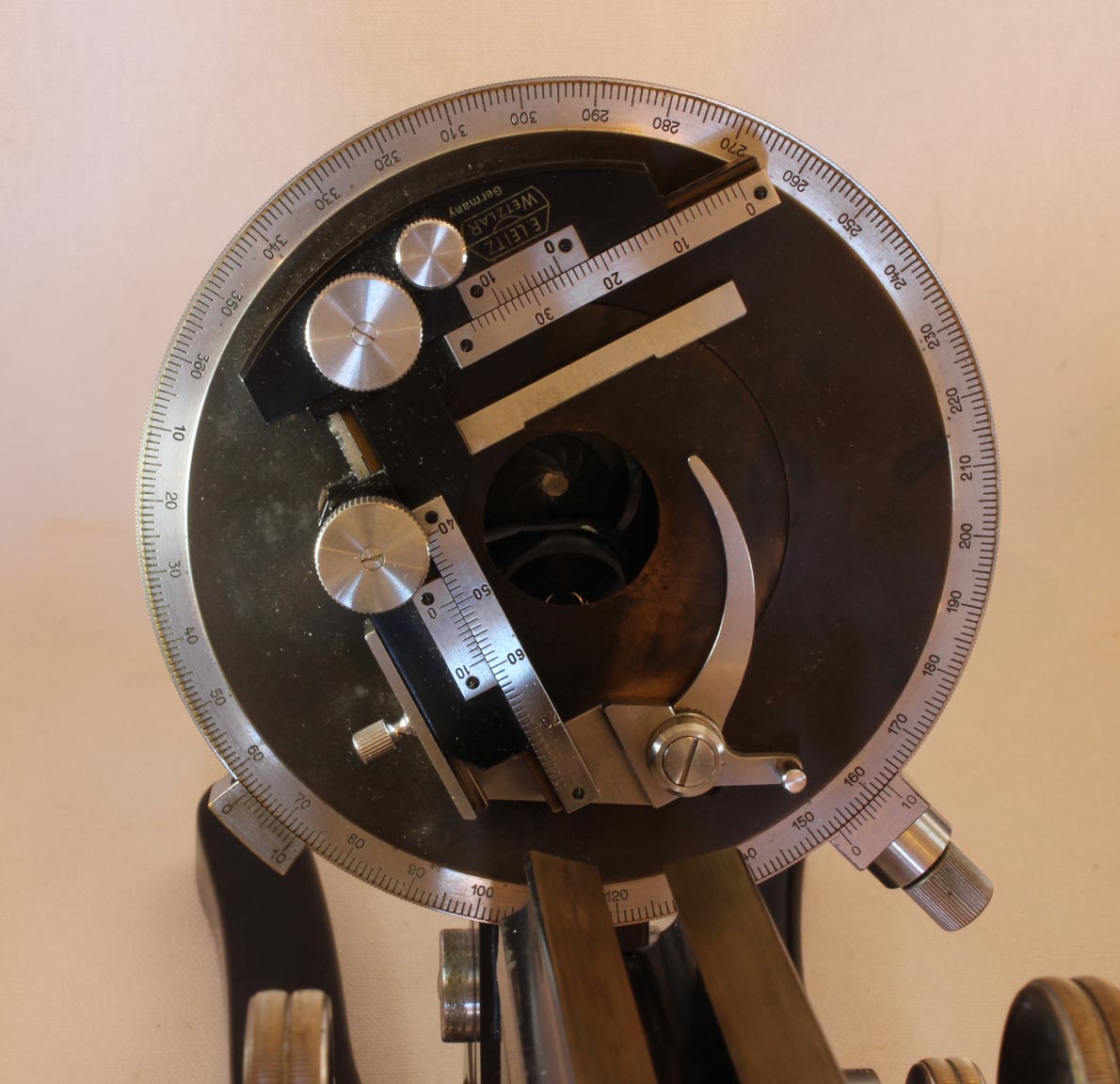 The stage is calibrated over 360 degrees in 1 degree increments with two verniers, (one on each side) allowing 1/10 degree readings.
A knurled knob works through the right vernier as a break to the stage rotation.
The special X-Y mechanical stage sits on the rotating stage platform. Each axis is calibrated in 1 mm increments with verniers allowing
readings to 1/10 of a mm. The stage motions are by diagonal rack and pinion.
The stage is calibrated over 360 degrees in 1 degree increments with two verniers, (one on each side) allowing 1/10 degree readings.
A knurled knob works through the right vernier as a break to the stage rotation.
The special X-Y mechanical stage sits on the rotating stage platform. Each axis is calibrated in 1 mm increments with verniers allowing
readings to 1/10 of a mm. The stage motions are by diagonal rack and pinion.

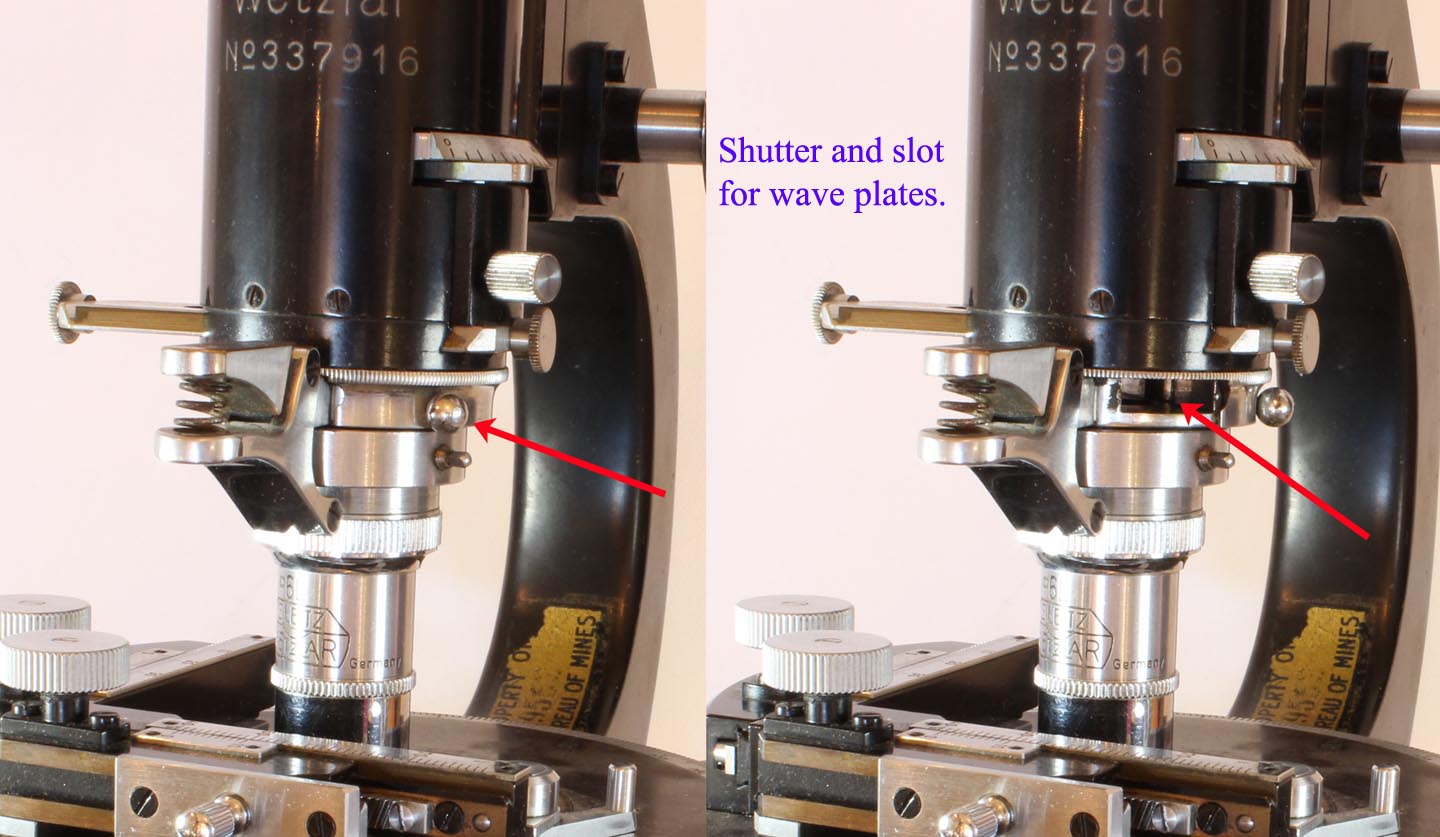 The Bertrand lens sits well above the analyzer. It can be focused by a diagonal rack and pinion.
There is a separate iris diaphragm integrated in to the Bertrand assembly. There are also two small knobs to adjust the centering of the Bertrand lens
in the optical axis.
The Bertrand lens sits well above the analyzer. It can be focused by a diagonal rack and pinion.
There is a separate iris diaphragm integrated in to the Bertrand assembly. There are also two small knobs to adjust the centering of the Bertrand lens
in the optical axis.
The analyzer is calibrated over a 90 degree range, in 5 degree increments, and has a rotation brake. It can be slid in or out of the optical path.
There is a window slot at the lower end of the nosepiece with a shutter which can be opened or closed via a small knob. This slot accepts the wave plates.
Each objective is held in place by a spring-loaded '3-point objective-changing clutch.' Each objective can be individually centered in the individual objective adapters accepting the society thread. Small wrenches are supplied for this purpose (see below).
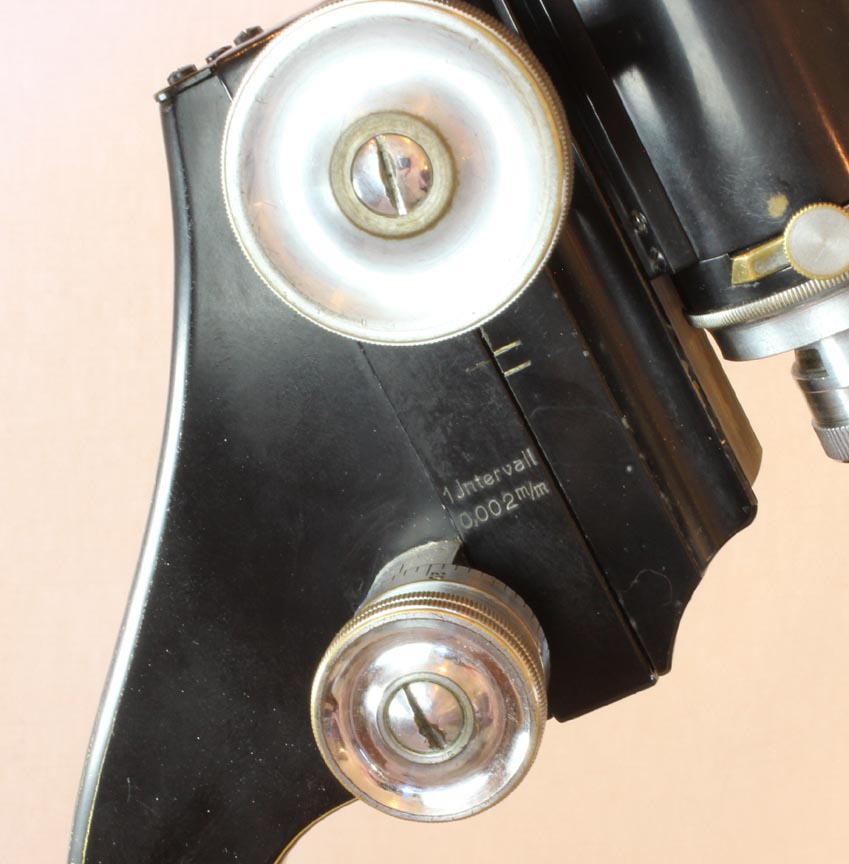 Coarse focusing is by diagonal rack and pinion. There is a side fine adjustment which is calibrated. An engraved area on the right side of the limb above the fine focus has the inscription: '1 Jntervall=0,002 m/m.' This is the exact inscription, likely an error in the engraving, as in German the word interval is spelled 'Intevall.' The diameter of the opening of the optical tube is large, to accept unusually large diameter oculars, and is supplied with an adapter, made of black plastic, to accept the supplied standard diameter oculars. No large diameter oculars are present.
Coarse focusing is by diagonal rack and pinion. There is a side fine adjustment which is calibrated. An engraved area on the right side of the limb above the fine focus has the inscription: '1 Jntervall=0,002 m/m.' This is the exact inscription, likely an error in the engraving, as in German the word interval is spelled 'Intevall.' The diameter of the opening of the optical tube is large, to accept unusually large diameter oculars, and is supplied with an adapter, made of black plastic, to accept the supplied standard diameter oculars. No large diameter oculars are present.
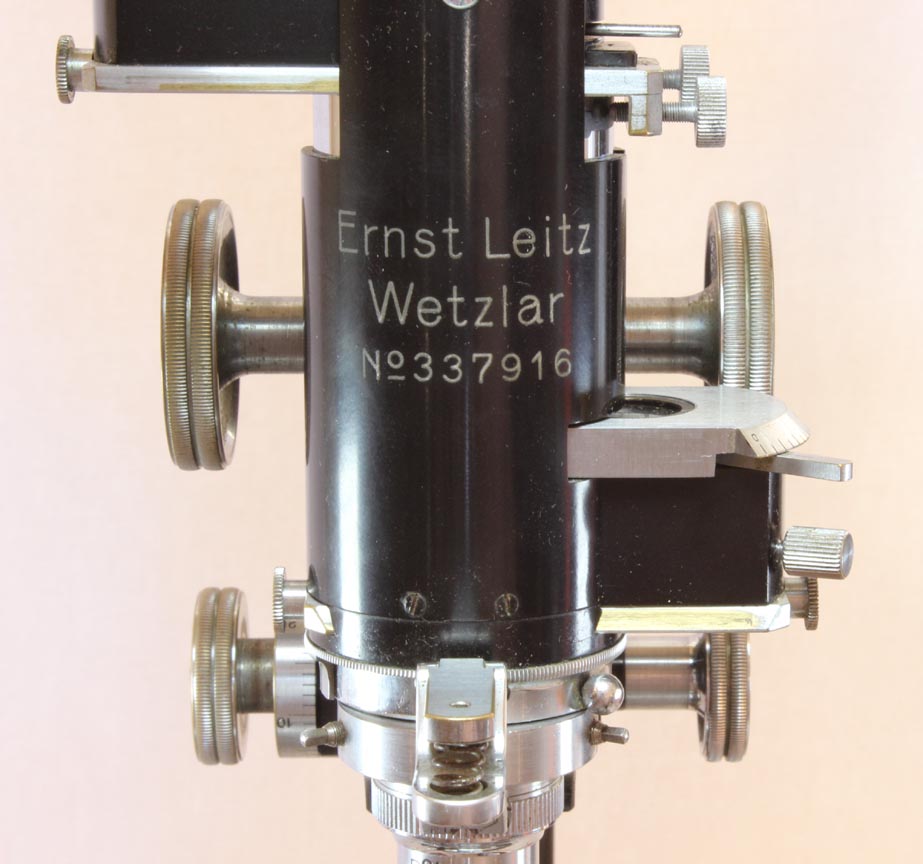
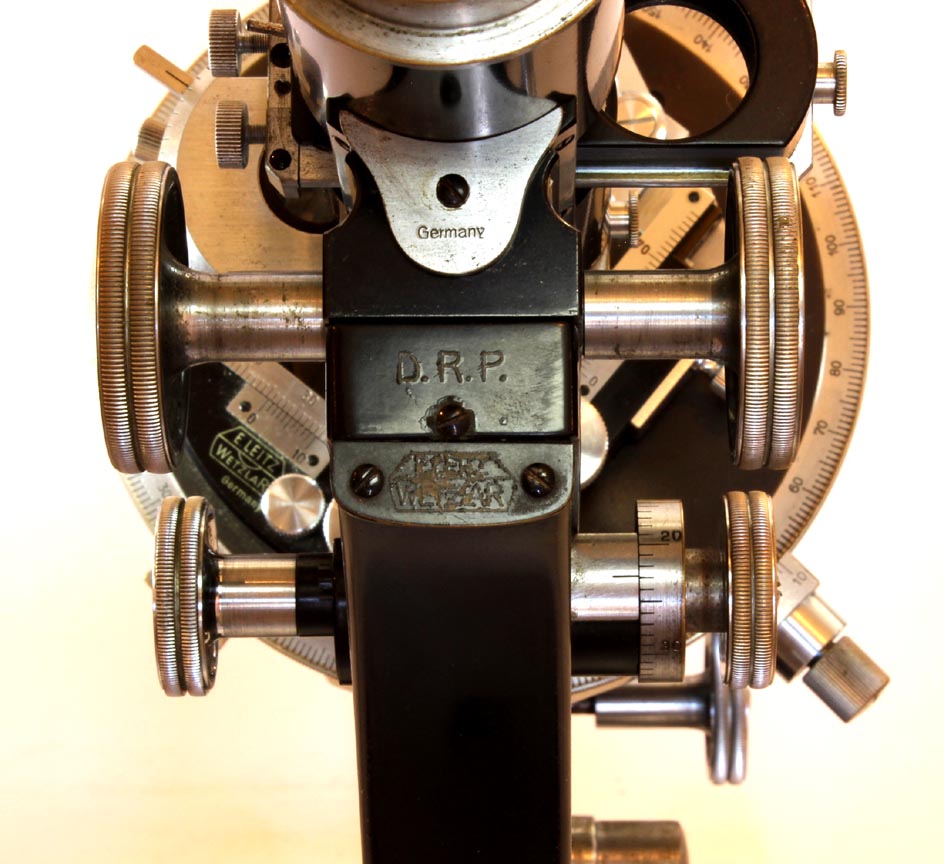 There are several signatures and a decal sticker. The sticker, on the lower inside surface of the limb identifies the former owner as the U.S. Bureau of
Mines, with a serial number that has partly worn off. The mechanical stage is signed 'Leitz, Wetzlar, Germany. The first two words are within the
Leitz emblem. The Main optical tube is signed: 'Ernst Leitz, Wetzlar, No337916.' The top of the limb is signed with the capital
initials: 'D.R.P. and below those letters, another 'Leitz, Wetzlar' insignia. Finally the plate at the top of the coarse focusing rack is signed:
'Germany.' The objectives also have signatures.
There are several signatures and a decal sticker. The sticker, on the lower inside surface of the limb identifies the former owner as the U.S. Bureau of
Mines, with a serial number that has partly worn off. The mechanical stage is signed 'Leitz, Wetzlar, Germany. The first two words are within the
Leitz emblem. The Main optical tube is signed: 'Ernst Leitz, Wetzlar, No337916.' The top of the limb is signed with the capital
initials: 'D.R.P. and below those letters, another 'Leitz, Wetzlar' insignia. Finally the plate at the top of the coarse focusing rack is signed:
'Germany.' The objectives also have signatures.
ACCESSORIES INCLUDE:
- The original case with key
- A removable finger-jointed box within the case with holds all the accessories except the oculars
- A removable wooden tray for oculars
- Eight individual centerable nosepiece fittings
- Two wrenches to adjust the nosepiece centering fittings
- Two wave plates, one labelled 'Glimmer ¼ λ and the other 'Gips rot I'
- Pol objective signed: 'p6L, (Leitz, Wetzlar in insignia), Germany,and on the other side: 'A=0.65, 45:1'
- Pol objective: 'p3, A=0.25, 10:1' and on the other side (Leitz, Wetzlar in insignia)
- A half lacquered-brass objective signed: '(E. LEITZ,WETZLAR in insignia) and also 'A.U., No9' and '5, 30X'
- A later objective signed: '170/0.17, 40/0.65,' and on the other side 'Leitz, WETZLAR, GERMANY
- An objective signed: 'COOKE' and on the other side: '20X 0.5' and also: 'C3876 MET.'
- An objective signed: 'VICKERS, N2053' and on the other side: 10/0.25
- Ocular, Signed: 'Ernst Leitz, Wetzlar, 6X, M.' with three scales, one vertical logarithmic scale calibrated 0-20, and two separate horizontal scales, one on each side of the vertical scale calibrated linearly from 0-30, right to left for the scale on the left side and 0-30, left to right on the right side
- Ocular, Signed: 'Periplan GF 16X, Ernst Leitz GmbH Wetzlar'
- A black plastic adapter for the oculars
- The optional mechanical stage
- The model 'aa' polarizing condensor assembly
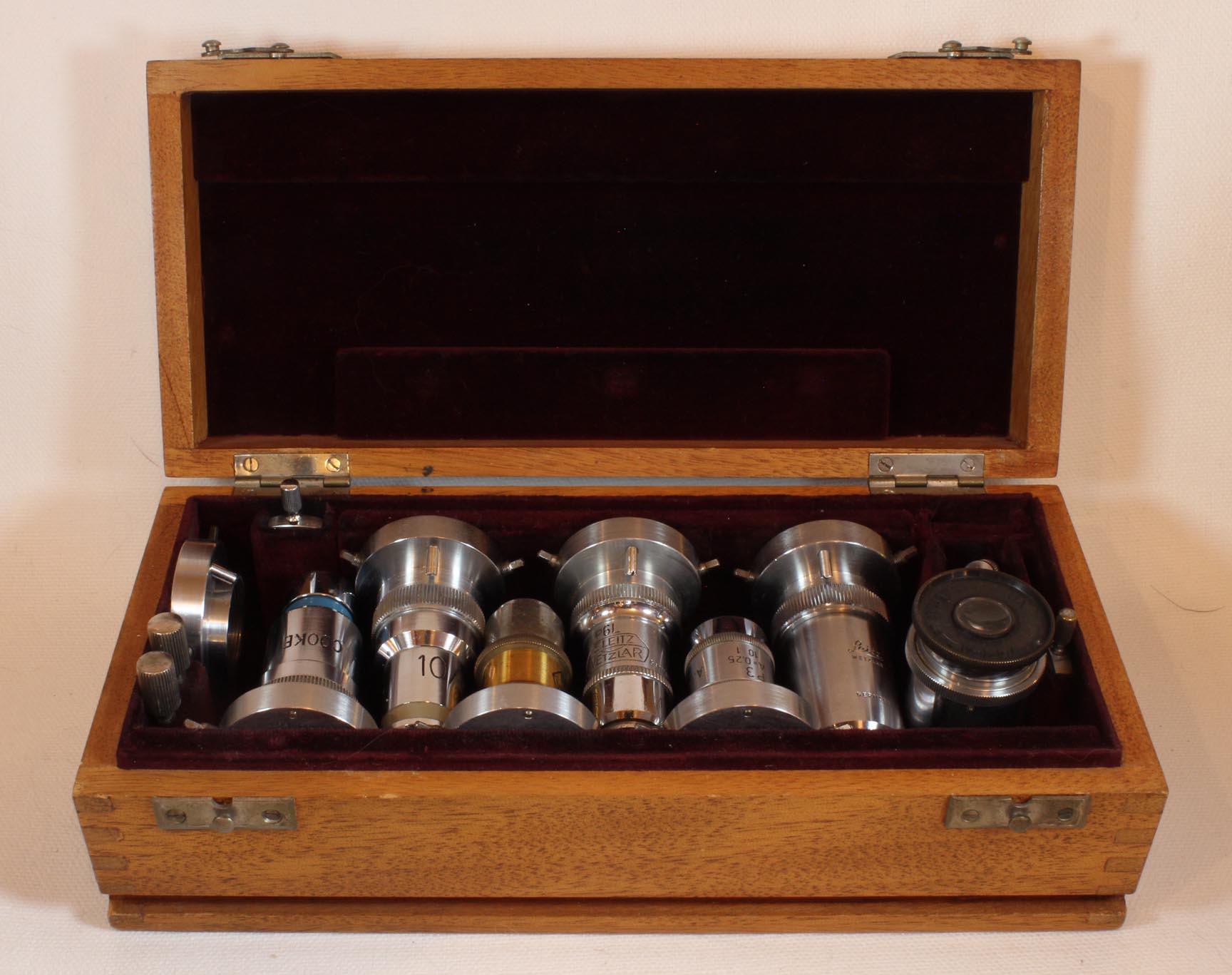
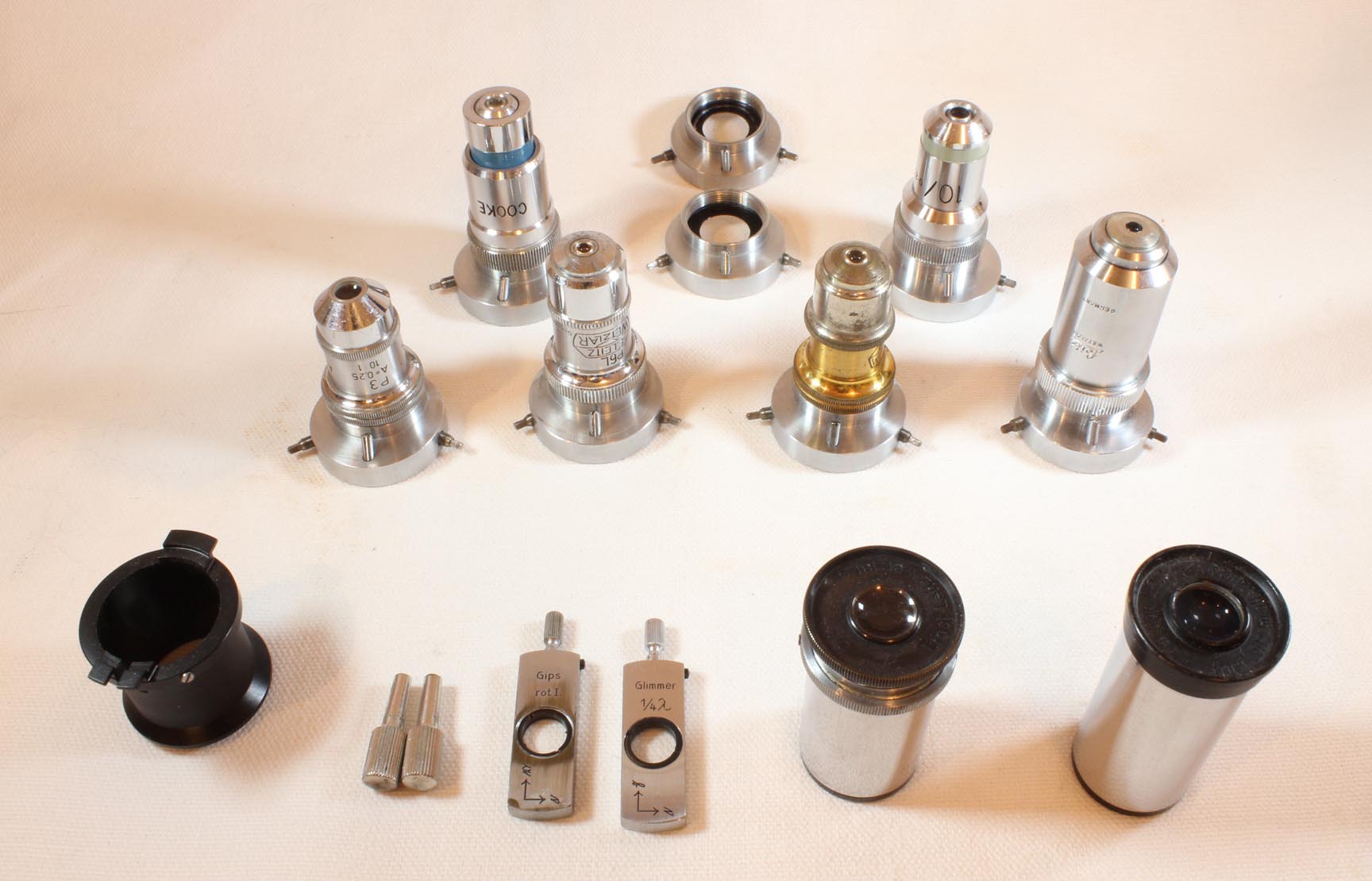
HISTORY OF THE LEITZ POLARIZING MICROSCOPES.
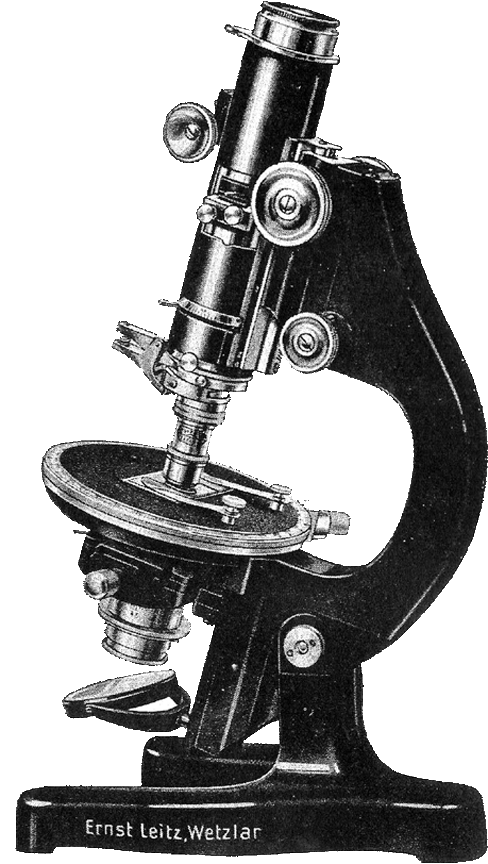 Leitz started producing polarizing microscopes after 1885. By 1890 there was a catalog listing for
a petrographic stand. There was even a specialized catalog for polarizing microscopes starting in 1893.
The famous Dr Berek (who refused to work for the Nazis), who was responsible for many important concepts in optics and polarizing microscopy, worked for the Leitz
company until his death in 1949. The condenser on this microscope is known as the model 'aa' Berek condenser, and was the most complex of the models offered. Ernst Leitz II
inherited the firm from his father and ran it during the 1930's and 1940's. During WWII Ernst Leitz II and his daughter were instrumental
in arranging for hundreds of Jewish families to escape the holocaust.
Leitz started producing polarizing microscopes after 1885. By 1890 there was a catalog listing for
a petrographic stand. There was even a specialized catalog for polarizing microscopes starting in 1893.
The famous Dr Berek (who refused to work for the Nazis), who was responsible for many important concepts in optics and polarizing microscopy, worked for the Leitz
company until his death in 1949. The condenser on this microscope is known as the model 'aa' Berek condenser, and was the most complex of the models offered. Ernst Leitz II
inherited the firm from his father and ran it during the 1930's and 1940's. During WWII Ernst Leitz II and his daughter were instrumental
in arranging for hundreds of Jewish families to escape the holocaust.
This is one of a long line of Leitz polarizing microscopes.
The IIIM was the student pol microscope for many years. During the early period, the MI and MII were the more sophisticated models. Later on, these designs became less promoted, and others were offered. The KM model had a larger diameter 30 mm tube. The GM added a slide-focusing Bertrand lens. This model, the CM, added rack and pinion focusing to the Bertrand lens, retaining the large diamter tube. The next design was the AM which gave the stage rack and pinion focusing. Then the BM was offered and included the mechanical stage as a standard fitting, whereas it was an extra accessory for this CM model. The CM model shown on this web page features an 'aa' model substage, and there were three others in succession, the a, b, and c. I am grateful to Dr John Field, an expert on Leitz microscopes, for this information on the evolution of the Leitz pol scopes.
It is the immediate precursor to
the CMU model which differs from this model only in that the model shown here has a rounded shape of the upright
supports from the foot, whereas the CMU model from about 1952 has squared off shaped supports. The CM was still
being advertised in 1949. As equipped, it sold in 1949 for what would be over $15,000 in 2013 dollars.
The author is greatful to Dr. John Field for his expertise in the history of Leitz microscopes and some of the illustrations provided herein.
*Thanks to Dr Tilman Halder for providing an exact date, as microscope number 337917, the very next number and precisely the same model, has a magnification card with the production date in the fall of 1938.
 The polarizer rotates through 360 degrees, graduated in 5 degree increments. It has a brake for its rotation, and at its bottom end there is an
iris diaphragm, the
distance of which from the prism can be varied by sliding it up or down. The polarizer assembly can slide in and out of the optical path on a dovetail.
It can be locked in the path with another brake.
The polarizer rotates through 360 degrees, graduated in 5 degree increments. It has a brake for its rotation, and at its bottom end there is an
iris diaphragm, the
distance of which from the prism can be varied by sliding it up or down. The polarizer assembly can slide in and out of the optical path on a dovetail.
It can be locked in the path with another brake.  The stage is calibrated over 360 degrees in 1 degree increments with two verniers, (one on each side) allowing 1/10 degree readings.
A knurled knob works through the right vernier as a break to the stage rotation.
The special X-Y mechanical stage sits on the rotating stage platform. Each axis is calibrated in 1 mm increments with verniers allowing
readings to 1/10 of a mm. The stage motions are by diagonal rack and pinion.
The stage is calibrated over 360 degrees in 1 degree increments with two verniers, (one on each side) allowing 1/10 degree readings.
A knurled knob works through the right vernier as a break to the stage rotation.
The special X-Y mechanical stage sits on the rotating stage platform. Each axis is calibrated in 1 mm increments with verniers allowing
readings to 1/10 of a mm. The stage motions are by diagonal rack and pinion. 
 The Bertrand lens sits well above the analyzer. It can be focused by a diagonal rack and pinion.
There is a separate iris diaphragm integrated in to the Bertrand assembly. There are also two small knobs to adjust the centering of the Bertrand lens
in the optical axis.
The Bertrand lens sits well above the analyzer. It can be focused by a diagonal rack and pinion.
There is a separate iris diaphragm integrated in to the Bertrand assembly. There are also two small knobs to adjust the centering of the Bertrand lens
in the optical axis.
 Coarse focusing is by diagonal rack and pinion. There is a side fine adjustment which is calibrated. An engraved area on the right side of the limb above the fine focus has the inscription: '1 Jntervall=0,002 m/m.' This is the exact inscription, likely an error in the engraving, as in German the word interval is spelled 'Intevall.' The diameter of the opening of the optical tube is large, to accept unusually large diameter oculars, and is supplied with an adapter, made of black plastic, to accept the supplied standard diameter oculars. No large diameter oculars are present.
Coarse focusing is by diagonal rack and pinion. There is a side fine adjustment which is calibrated. An engraved area on the right side of the limb above the fine focus has the inscription: '1 Jntervall=0,002 m/m.' This is the exact inscription, likely an error in the engraving, as in German the word interval is spelled 'Intevall.' The diameter of the opening of the optical tube is large, to accept unusually large diameter oculars, and is supplied with an adapter, made of black plastic, to accept the supplied standard diameter oculars. No large diameter oculars are present. 
 There are several signatures and a decal sticker. The sticker, on the lower inside surface of the limb identifies the former owner as the U.S. Bureau of
Mines, with a serial number that has partly worn off. The mechanical stage is signed 'Leitz, Wetzlar, Germany. The first two words are within the
Leitz emblem. The Main optical tube is signed: 'Ernst Leitz, Wetzlar, No337916.' The top of the limb is signed with the capital
initials: 'D.R.P. and below those letters, another 'Leitz, Wetzlar' insignia. Finally the plate at the top of the coarse focusing rack is signed:
'Germany.' The objectives also have signatures.
There are several signatures and a decal sticker. The sticker, on the lower inside surface of the limb identifies the former owner as the U.S. Bureau of
Mines, with a serial number that has partly worn off. The mechanical stage is signed 'Leitz, Wetzlar, Germany. The first two words are within the
Leitz emblem. The Main optical tube is signed: 'Ernst Leitz, Wetzlar, No337916.' The top of the limb is signed with the capital
initials: 'D.R.P. and below those letters, another 'Leitz, Wetzlar' insignia. Finally the plate at the top of the coarse focusing rack is signed:
'Germany.' The objectives also have signatures. Leitz started producing polarizing microscopes after 1885. By 1890 there was a catalog listing for
a petrographic stand. There was even a specialized catalog for polarizing microscopes starting in 1893.
The famous Dr Berek (who refused to work for the Nazis), who was responsible for many important concepts in optics and polarizing microscopy, worked for the Leitz
company until his death in 1949. The condenser on this microscope is known as the model 'aa' Berek condenser, and was the most complex of the models offered. Ernst Leitz II
inherited the firm from his father and ran it during the 1930's and 1940's. During WWII Ernst Leitz II and his daughter were instrumental
in arranging for hundreds of Jewish families to escape the holocaust.
Leitz started producing polarizing microscopes after 1885. By 1890 there was a catalog listing for
a petrographic stand. There was even a specialized catalog for polarizing microscopes starting in 1893.
The famous Dr Berek (who refused to work for the Nazis), who was responsible for many important concepts in optics and polarizing microscopy, worked for the Leitz
company until his death in 1949. The condenser on this microscope is known as the model 'aa' Berek condenser, and was the most complex of the models offered. Ernst Leitz II
inherited the firm from his father and ran it during the 1930's and 1940's. During WWII Ernst Leitz II and his daughter were instrumental
in arranging for hundreds of Jewish families to escape the holocaust.